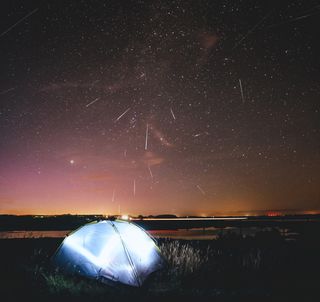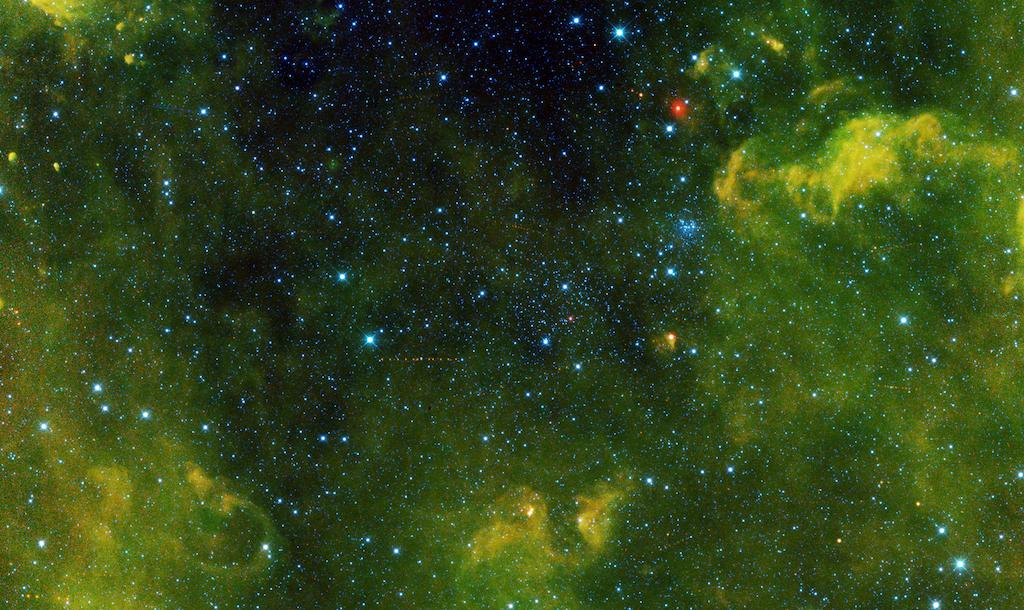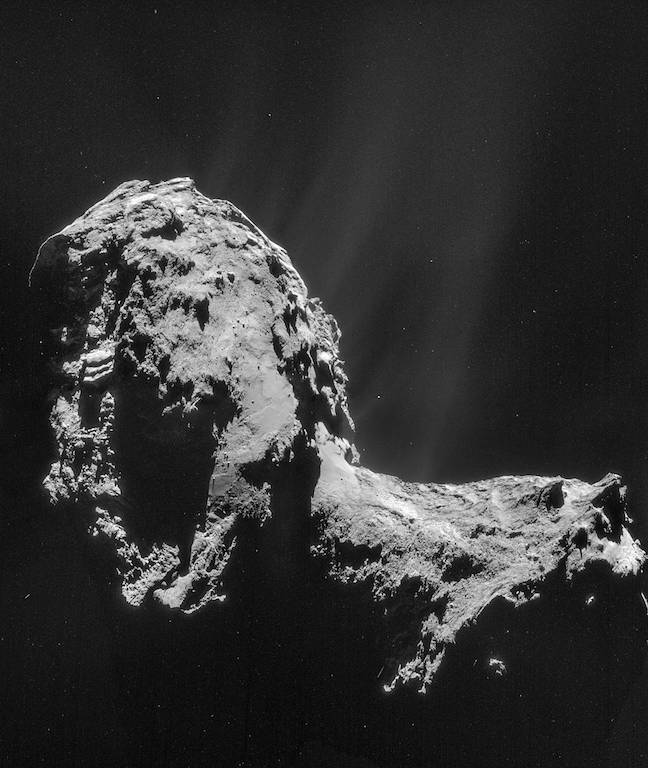Where Are Most of the Known Asteroids Found Quizlet
What's the Difference Betwixt Asteroids, Comets and Meteors?

In our solar system there are billions, possibly trillions, of varlet objects orbiting the sun. These spacefarers are as well small to be called planets and are given the names of comets, asteroids, meteoroids, and if they reach Earth, meteors Oregon meteorites. With so galore labels, it's easy to forget which is which.
Countenance's start with a brief definition of each.
Asteroids: These are the unsmooth and airless leftovers from the formation of planets in our solar system. They largely orbit our sun in the asteroid belt between Mars and Jupiter and range from the size of cars to dwarf planets.
Comets: Comets are dirty space snowballs of largely ice and dust that eel-shaped during the nascence of the star system 4.6 billion years ago. About comets receive stable orbits in the satellite reaches of the solar system past the planet Neptune.
Meteoroids, Meteors, Meteorites: Meteoroids are tiny asteroids operating room the broken-off crumbs of comets and sometimes planets. They kitchen stove in size from a grain of sand to boulders 3 feet (1 meter) wide. When meteoroids collide with a planet's standard atmosphere, they become meteors. If those meteors survive the atmosphere and hit the major planet's surface, their corpse are called meteorites.
Related: Fallen Stars: A Drift of Famous Meteorites
Asteroids
Initially coup d'oeil, asteroids Crataegus oxycantha appear like mine run blank rocks, but these ancient solar system remnants come in all shapes, sizes and flavors.
Despite their small stature (the mass of all the asteroids combined is less than Solid ground's daydream), asteroids are also called minor planets or "planetoids." They range in sized from the smallest boulders, 3 feet across (1 m), to the largest asteroid, Ceres, which is nearly a quarter the size of Earth's lunation (close to 590 miles in diameter, OR 950 kilometers). Ceres is so large, it received a publicity to the status of a dwarf major planet in 2006, the same moot distinction given to Pluto.
Virtually asteroids aspect like-minded giant infinite potatoes, with their unsubdivided shapes and surface that's pockmarked by numerous craters caused aside collisions with other asteroids. Only a small number of asteroids are large enough that their sobriety forms them into spheres, such as Ceres. The composition of asteroids chain from dark, rocky clumps of detritus consisting of clay and silicate rocks to bright and solid amalgamations of metals much as iron operating theater nickel, according to NASA.
Nearly all asteroids are found in a doughnut-shaped region between Mars and Jove, called the asteroid whang. The knock formed shortly aft the birth of Jupiter when the massive satellite's gravity trapped planet-forming leftovers, causation them to strike one another and form the millions of asteroids we see in the swath today.

Comets
For millennia, the sight of a comet elicited fear and reverence. Ancient astronomers believed comets foretold the death of princes and the outcomes of wars. Modern astronomers know comets are the ice-dolled up leftovers from the physical that formed our solar system billions of years ago.
Astronomer Fred Whipple was the first to describe comets as dirty snowballs, or icy conglomerates of frozen gases and dust. The snowball makes up the central nucleus of a comet, which is often fewer than few miles across, according to NASA. When a comet nears the Dominicus, the karyon warms up and the ice begins to sublime from undiversified to gas. This produces an aura surrounding the comet that can grow to thousands of miles in diameter, named a coma. Corpuscular-radiation pressure from the sun blows away the dust particles in the comatoseness to produce a long, bright detritus tail. A second hind end is bacillary when high-energy star particles ionize the gas, creating a separate ion tail.
The difference between the composition of asteroids and comets is belik due to how and where they were innate, wrote Britt Scharringhausen, a professor of uranology at Beloit College in Wisconsin River.
"While asteroids and comets did form at the identical time, they did not form under quite the same conditions," Scharringhausen wrote. "The star system of rules formed from the solar nebula, a cloud of gas and dust. At the center of the nebula, the sun was being born through gravitational collapse. Because of this collapse, which releases heat, the central regions of the nebula were hotter and denser, while the outer regions were cooler."
Asteroids club-shaped near the center of the hot nebula where only rock or metal remained solid nether immoderate temperatures. Comets formed beyond what's called the freeze line, where it was far sufficiency for water and gases same carbonic acid gas to freeze. Because of this, comets by and large are found only in the far reaches of the solar scheme in two regions named the Kuiper Belt and the Oort Cloud.

Meteoroids, Meteors and Meteorites
Meteoroids are the true distance rocks of the star system. No large than a measure in size (3.3 feet) and sometimes the size of a food grain of dust, they are too dinky to be considered asteroids operating room comets, but many are the dashed pieces of either. Whatsoever meteoroids start from the ejected debris caused by impacts on planets or moons.
If meteoroids happen to cross paths with a planet's atmosphere, like Earth's, they become meteors. The fiery flash given off by meteors when they burn finished in the standard pressure can appear brighter than the major planet Urania, which is wherefore they've earned the nickname "shot stars," according to NASA. Scientists estimate more than 48 tons (43,500 kilograms) of meteoroid material falls to Earth every day. If a meteor survives its descent through the atmosphere and hits the ground, it's named a meteorite.
When Earth passes through the trail of debris left by a comet we're sunbaked to the dazzling fireworks reveal of a shooting star shower, where thousands of shot stars can cost seen in the night sky. The Perseid meteor cascade is one of the most prominent, occuring every year around Aug. 12. At its peak, 50 to 75 meteors can be seen per hour if the toss is clear. The Perseids are caused by the meteoroids impaired off from Comet Swift-Tuttle.
These brilliant meteoroid showers dish up as a reminder that despite the on the face of it empty expanse of blank, we'atomic number 75 more intimately connected to our solar system than we imagine.
Additional resources:
- Memorise both very unknown things most comets revealed by the Rosetta spacecraft, from Space.com.
- Read about NASA's Dawn program, a mission to learn asteroids, from Space.com.
- Watch this animation of all known asteroids and comets in the star system between 1999 and 2018, from NASA Jet Propulsion Lab.
Where Are Most of the Known Asteroids Found Quizlet
Source: https://www.livescience.com/difference-between-asteroids-comets-and-meteors.html
Belum ada Komentar untuk "Where Are Most of the Known Asteroids Found Quizlet"
Posting Komentar